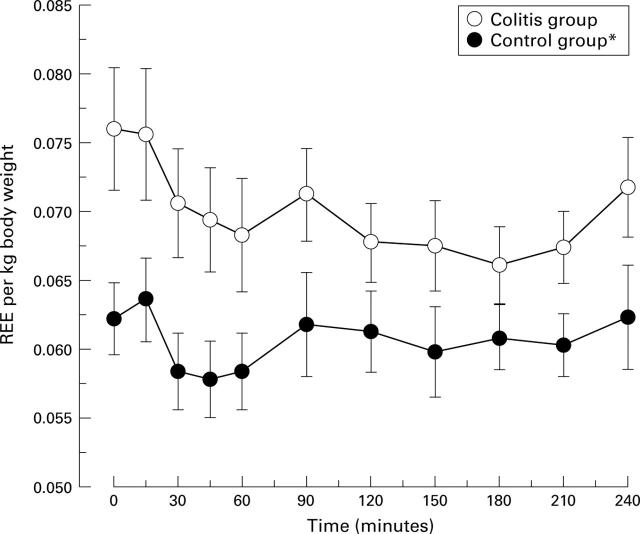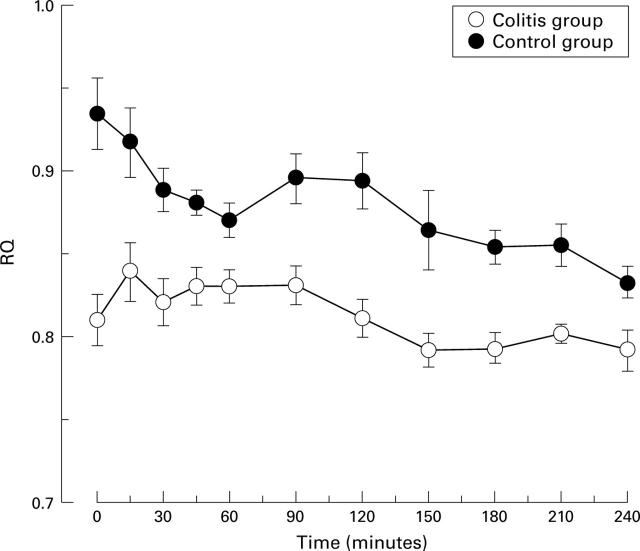Abstract
BACKGROUND—Butyrate, a short chain fatty acid produced by bacterial fermentation, is a major fuel source for the colonocyte. In vitro work has shown that ulcerative colitis may be characterised by a metabolic defect in colonocyte butyrate oxidation. AIMS—To investigate the rate of metabolism of rectally administered butyrate in patients with quiescent colitis. METHODS—[1-13C]-butyrate enemas were administered to 11 patients with long standing quiescent ulcerative colitis and to 10 control patients. The rate of production of 13CO2 in exhaled breath over four hours was measured by isotope ratio mass spectrometry combined with indirect calorimetry in order to measure CO2 production. This allowed calculation of the patients' resting energy expenditure and respiratory quotient. RESULTS—Over a four hour period, 325 (SEM 21) µmol 13CO2 was recovered in breath samples from the colitis group compared with 322 (17) µmol from the control group (NS). The respiratory quotient of the colitic group was significantly lower than that of the control group. CONCLUSION—There was no difference in the rate of metabolism of butyrate between the two groups. It is unlikely that there is a primary metabolic defect of butyrate metabolism in patients with quiescent ulcerative colitis. Keywords: ulcerative colitis; in vivo butyrate metabolism
Full Text
The Full Text of this article is available as a PDF (97.6 KB).
Figure 1 .
Resting energy expenditure (REE) over the duration of the study in patients with colitis and control subjects. *p<0.05.
Figure 2 .
Mean respiratory quotient (RQ) over time in patients with colitis and control subjects. Group × time, p<0.001 (group ANOVA).
Figure 3 .
13CO2 production per kJ of energy expenditure over the time course of the experiment. Group × time, p<0.05 (ANOVA).
Selected References
These references are in PubMed. This may not be the complete list of references from this article.
- Allan E. S., Winter S., Light A. M., Allan A. Mucosal enzyme activity for butyrate oxidation; no defect in patients with ulcerative colitis. Gut. 1996 Jun;38(6):886–893. doi: 10.1136/gut.38.6.886. [DOI] [PMC free article] [PubMed] [Google Scholar]
- Chapman M. A., Grahn M. F., Boyle M. A., Hutton M., Rogers J., Williams N. S. Butyrate oxidation is impaired in the colonic mucosa of sufferers of quiescent ulcerative colitis. Gut. 1994 Jan;35(1):73–76. doi: 10.1136/gut.35.1.73. [DOI] [PMC free article] [PubMed] [Google Scholar]
- Chapman M. A., Grahn M. F., Giamundo P., O'Connell P. R., Onwu D., Hutton M., Maudsley J., Norton B., Rogers J., Williams N. S. New technique to measure mucosal metabolism and its use to map substrate utilization in the healthy human large bowel. Br J Surg. 1993 Apr;80(4):445–449. doi: 10.1002/bjs.1800800412. [DOI] [PubMed] [Google Scholar]
- Chapman M. A., Grahn M. F., Hutton M., Williams N. S. Butyrate metabolism in the terminal ileal mucosa of patients with ulcerative colitis. Br J Surg. 1995 Jan;82(1):36–38. doi: 10.1002/bjs.1800820115. [DOI] [PubMed] [Google Scholar]
- Clausen M. R., Mortensen P. B. Kinetic studies on colonocyte metabolism of short chain fatty acids and glucose in ulcerative colitis. Gut. 1995 Nov;37(5):684–689. doi: 10.1136/gut.37.5.684. [DOI] [PMC free article] [PubMed] [Google Scholar]
- Cummings J. H. Short chain fatty acids in the human colon. Gut. 1981 Sep;22(9):763–779. doi: 10.1136/gut.22.9.763. [DOI] [PMC free article] [PubMed] [Google Scholar]
- Den Hond E., Hiele M., Evenepoel P., Peeters M., Ghoos Y., Rutgeerts P. In vivo butyrate metabolism and colonic permeability in extensive ulcerative colitis. Gastroenterology. 1998 Sep;115(3):584–590. doi: 10.1016/s0016-5085(98)70137-4. [DOI] [PubMed] [Google Scholar]
- Fellows I. W., Macdonald I. A. An automated method for the measurement of oxygen consumption and carbon dioxide excretion in man. Clin Phys Physiol Meas. 1985 Nov;6(4):349–355. doi: 10.1088/0143-0815/6/4/007. [DOI] [PubMed] [Google Scholar]
- Finnie I. A., Taylor B. A., Rhodes J. M. Ileal and colonic epithelial metabolism in quiescent ulcerative colitis: increased glutamine metabolism in distal colon but no defect in butyrate metabolism. Gut. 1993 Nov;34(11):1552–1558. doi: 10.1136/gut.34.11.1552. [DOI] [PMC free article] [PubMed] [Google Scholar]
- Fukagawa N. K., Bandini L. G., Young J. B. Effect of age on body composition and resting metabolic rate. Am J Physiol. 1990 Aug;259(2 Pt 1):E233–E238. doi: 10.1152/ajpendo.1990.259.2.E233. [DOI] [PubMed] [Google Scholar]
- Harig J. M., Soergel K. H., Komorowski R. A., Wood C. M. Treatment of diversion colitis with short-chain-fatty acid irrigation. N Engl J Med. 1989 Jan 5;320(1):23–28. doi: 10.1056/NEJM198901053200105. [DOI] [PubMed] [Google Scholar]
- Hove H., Holtug K., Jeppesen P. B., Mortensen P. B. Butyrate absorption and lactate secretion in ulcerative colitis. Dis Colon Rectum. 1995 May;38(5):519–525. doi: 10.1007/BF02148853. [DOI] [PubMed] [Google Scholar]
- Mascolo N., Rajendran V. M., Binder H. J. Mechanism of short-chain fatty acid uptake by apical membrane vesicles of rat distal colon. Gastroenterology. 1991 Aug;101(2):331–338. doi: 10.1016/0016-5085(91)90008-9. [DOI] [PubMed] [Google Scholar]
- Patz J., Jacobsohn W. Z., Gottschalk-Sabag S., Zeides S., Braverman D. Z. Treatment of refractory distal ulcerative colitis with short chain fatty acid enemas. Am J Gastroenterol. 1996 Apr;91(4):731–734. [PubMed] [Google Scholar]
- Roediger W. E., Nance S. Metabolic induction of experimental ulcerative colitis by inhibition of fatty acid oxidation. Br J Exp Pathol. 1986 Dec;67(6):773–782. [PMC free article] [PubMed] [Google Scholar]
- Roediger W. E., Rae D. A. Trophic effect of short chain fatty acids on mucosal handling of ions by the defunctioned colon. Br J Surg. 1982 Jan;69(1):23–25. doi: 10.1002/bjs.1800690108. [DOI] [PubMed] [Google Scholar]
- Roediger W. E. Role of anaerobic bacteria in the metabolic welfare of the colonic mucosa in man. Gut. 1980 Sep;21(9):793–798. doi: 10.1136/gut.21.9.793. [DOI] [PMC free article] [PubMed] [Google Scholar]
- Roediger W. E. The colonic epithelium in ulcerative colitis: an energy-deficiency disease? Lancet. 1980 Oct 4;2(8197):712–715. doi: 10.1016/s0140-6736(80)91934-0. [DOI] [PubMed] [Google Scholar]
- Scheppach W., Sommer H., Kirchner T., Paganelli G. M., Bartram P., Christl S., Richter F., Dusel G., Kasper H. Effect of butyrate enemas on the colonic mucosa in distal ulcerative colitis. Gastroenterology. 1992 Jul;103(1):51–56. doi: 10.1016/0016-5085(92)91094-k. [DOI] [PubMed] [Google Scholar]
- Scheppach W. Treatment of distal ulcerative colitis with short-chain fatty acid enemas. A placebo-controlled trial. German-Austrian SCFA Study Group. Dig Dis Sci. 1996 Nov;41(11):2254–2259. doi: 10.1007/BF02071409. [DOI] [PubMed] [Google Scholar]
- Steinhart A. H., Hiruki T., Brzezinski A., Baker J. P. Treatment of left-sided ulcerative colitis with butyrate enemas: a controlled trial. Aliment Pharmacol Ther. 1996 Oct;10(5):729–736. doi: 10.1046/j.1365-2036.1996.d01-509.x. [DOI] [PubMed] [Google Scholar]
- Weaver G. A., Krause J. A., Miller T. L., Wolin M. J. Cornstarch fermentation by the colonic microbial community yields more butyrate than does cabbage fiber fermentation; cornstarch fermentation rates correlate negatively with methanogenesis. Am J Clin Nutr. 1992 Jan;55(1):70–77. doi: 10.1093/ajcn/55.1.70. [DOI] [PubMed] [Google Scholar]
- Weaver G. A., Tangel C. T., Krause J. A., Parfitt M. M., Jenkins P. L., Rader J. M., Lewis B. A., Miller T. L., Wolin M. J. Acarbose enhances human colonic butyrate production. J Nutr. 1997 May;127(5):717–723. doi: 10.1093/jn/127.5.717. [DOI] [PubMed] [Google Scholar]





